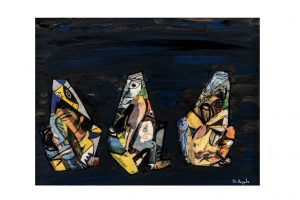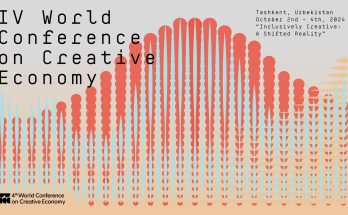
What is it about Indian women that fascinate another woman? Ask Stephanie Arpels, the Delhi-based French artist, who is dedicating her upcoming solo show, Women Passing, on the different facets of Indian women. She captures them in totality. Their gaiety, their laughter, their energy, their hidden pain beneath those happy faces. “Even in dire situations they are striking and I am in awe of them,” says Arpels of her subjects.
She began observing and studying Indian women since she and her family – husband and son – relocated to Indian in 2015. For someone who grew up in Arras in North of France, a country that witnessed many changes and evolution in the role of women in the society including a recent achievement on her country being awarded a top score on gender equality, it is only natural that Arpels is intrigued by Indian women. Her focus on the subject is more than just a mere curiosity. It is with a very thoughtful intent to bring to light the place Indian women occupy and how they have carved a niche for themselves in the male dominated society. And their struggles and victories in a world that constantly make her a victim.

The artist in her is always alert to study her subject. Whether she is travelling in Pushkar in Rajasthan or, simply meandering around Nizamuddin market, her home in India, there is never a moment that escapes her mind. She makes a mental note of every woman she interacts with and, uses them as an inspiration. It could be Rajasthani women clad in colourful saris hiding their faces or, fiercely independent urban Indian woman going about her way to work. Women’s status has been her concern for the longest time for Arpels who took to painting as a teenager back home. In fact, it was her means to express herself all through her doubting years of adolescence. When she felt misunderstood as a young adult, she took to drawing geometrical shapes to escape and dream of a better world.
No wonder, her tilt has always been towards representing the inner beauty of women. Incidentally, she also takes refuge in her art as a healing process to fight a life-altering disease. She draws renewed strength from her work – giving her the much needed energy to live each day with positivity.
Her brush captures the many faces of women and, she is fully aware that strength and fragility go hand in hand just as confidence and complexities are inseparable partners. All that intrinsic truth, she is able to capture them in the deeper layers of her narration.
Arpels, who also wears the hat of a doting mother to a seven-year-old son, and a dedicated wife to a man who believes in spoiling her with his culinary skills, is thoughtful and mindful. The artist in her is vividly embedded in her system and she lives every moment wholeheartedly. It is perhaps her realization that life itself is transitory and, often seems as if the very existence of man hangs only on a flimsy thread. “I have dedicated my work to subliming women,” she says.
Her work rightly represents the dimensions she perceives in the life of the many women she has interacted, observed and studied. Last year, Arpels was awarded by the Ministry of Women and Child Development for excellence in the field of art.
Stephanie Arpels tells Hoihnu Hauzel what is so intriguing about Indian women and why her narration is so special.
(Excerpts from the interview)
In what way has India impact your work?
My move to India in 2015 has impacted my work in many ways. I am moved by what I see and feel. The vastness of the country challenges me to show the diversity and contrasts among Indian women. Their gaiety, their laughter, their energy, whatever their social status, are striking. I am naturally in awe of what it offers me. They keep smiling even in the direst conditions.
My move to India allows me to brighten my canvases and my models with colorful women. Indian women are brighter than European women. By this I mean that Indian women tend to display or project more light than European women literally given their choice of colours in cothes, their spirituality that inhabits them. Naturally, my canvases increase in sizes. The vastness of India invites me to express the diversity and the contrasts of Indian women.
What influence you in your work?
I am inspired by personal events, emotions, spiritual moments and energy of women in daily life. Most of the time, I paint according to my emotions. My paint is a profound means of expression. It is a manner to cure myself and to escape. I am passionate about women and their complexities. I am moved by what I see, and I feel it.
In your upcoming show, women of India are the central focus — what is so captivating about Indian women?
This new series is focused on the ways in which the spirituality of Indian women resonates with mine. I am one with her. My art represents the dimensions I perceive in the life of the women. And I pose questions like: Where are they going? What will become of them?
I wonder about the present and the future, about that which can be seen, and also the unknown.And interpret this in my new art. In the process, what is happening is that an inner spiritual awakening is taking over my work on Indian women.
I set my women in other worlds where they appear in different sizes, whether they are in the foreground or the background.
I observe the inner beauty of women, suspended in time and space, where they can embrace their future destinations.My Indian women are in harmony with themselves and with their environment, their surroundings;accepting their fate happily and graciously.
You use vivid colours in your visual narratives. Why are colours so significant in your story telling?

I use saturated black, red and blue colors to unveil the sensuality of the curve of women’s bodies, but also, in equal measure I capture emotions like love, anger, power, life, evoking what I witness daily. I rely on collages in my paintings as a way to make the faces on the silhouettes seem more real and accessible. To dress up my women and to respect their emotions and their intimacy while describing the diversity and depth of their feelings.
Colors that I apply in my landscapes are essential for me too. Blue for me stands for nature and infinity. It symbolises peace, calm, serenity. White represents purity and paradise. Brown is for nature and earth. Green is for nature, stability, energy. Taupe is a color that travels through time. I feel it is timeless. Shades of white and beige, and darker colors invade my canvases, translating the contrasts of different worlds. Lastly, I use grey and black to illustrate my distress towards the unknown, and emptiness. I interpret women resting, squatting, dancing, walking, dreaming, and passing in landscapes.
I observe the inner beauty of women, suspended in time and space, where they can embrace their future destinations.
I set my women in other worlds where they appear in different sizes, whether they are in the foreground or the background.
They vanish in my landscapes and on the paths that I paint always larger, to immerse them in the unknown; an imagined paradise, a serenity.
In some of my canvases, my Indian women take flight on their way to reincarnation, a rebirth towards another body and a better life.
They are in harmony with themselves and with their environment, their surroundings; accepting their fate graciously. The spirituality of Indian women resonates with mine. I am one with them.
What is it about Indian women that fascinate you? Inspiring when you look at them from your eye (artist)?
I am deeply connected with the spirituality of India.Women, as species, fascinate me, because we always have to struggle to obtain more freedom, but have not yet become the equal of men.
Women give life. They have the unique gift to be several persons in one. However, despite the evolution of mentalities, women are still not considered equal to men and must struggle to find their place.
Indian women inspire me. I feel the spiritual power that lives in them to endure their life gives them the strength to support their family. In a way, my work is to pay tribute to the beauty of these women. I admire them.
If you compare Western women with Indian women what is or, are the main differences that set them apart.
There are far too many factors that distinguish women in both these continents. For instance these factors play a significant role. History, tradition, culture, economic evolution and progress, significantly influence behavior. The West and India have not followed the same path and pattern resulting in unique differences. India is a country of paradoxes while the West is more or less uniform. In the West, Women’s life tend to focus more on the “now” whereas in India, the live of women are driven by reincarnation resulting in profound quest for spirituality that imbibes and dictates all their behavior. I see that women in the West do not fully enjoy their good fortune to live free and independently, while an inner joy emerges from the soul of Indian women. And I have seen how even in the most difficult circumstances that inner joy takes over everything else in life.
What medium do you use through your painting journey? And how different is this exhibition?
I have begun painting with acrylic. Later, I have introduced collages of works I select from the painters I admire the most, to sublime and give more importance to my Indian women that I dress up. I have associate Western and Indian painters highlighting my European roots in an Indian context as live in Delhi. It is also a way to translate my European perception of Indian traditions, as my collages represent the traditional sari. In this new exhibition, I have used resin to sublime my Indian women even more.
WOMEN PASSING
A solo exhibition by Stéphanie ARPELS, French Artist
Dates of the exhibition : December 5-9
Gallery/space appointed: Habitat Visual Arts Gallery
Author Profile
- India Writes Network (www.indiawrites.org) is an emerging think tank and a media-publishing company focused on international affairs & the India Story. Centre for Global India Insights is the research arm of India Writes Network. To subscribe to India and the World, write to editor@indiawrites.org. A venture of TGII Media Private Limited, a leading media, publishing and consultancy company, IWN has carved a niche for balanced and exhaustive reporting and analysis of international affairs. Eminent personalities, politicians, diplomats, authors, strategy gurus and news-makers have contributed to India Writes Network, as also “India and the World,” a magazine focused on global affairs.
Latest entries
 DiplomacyJanuary 5, 2026India walks diplomatic tightrope over US operation in Venezuela
DiplomacyJanuary 5, 2026India walks diplomatic tightrope over US operation in Venezuela India and the WorldNovember 26, 2025G20@20: Africa’s Moment – The Once and Future World Order
India and the WorldNovember 26, 2025G20@20: Africa’s Moment – The Once and Future World Order DiplomacyOctober 4, 2025UNGA Resolution 2758 Must Not Be Distorted, One-China Principle Brooks No Challenge
DiplomacyOctober 4, 2025UNGA Resolution 2758 Must Not Be Distorted, One-China Principle Brooks No Challenge India and the WorldJuly 26, 2025MPs, diplomats laud Operation Sindoor, call for national unity to combat Pakistan-sponsored terror
India and the WorldJuly 26, 2025MPs, diplomats laud Operation Sindoor, call for national unity to combat Pakistan-sponsored terror







